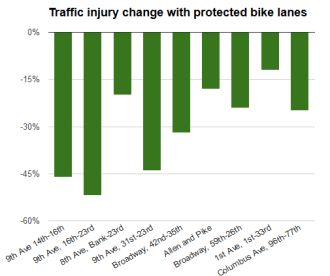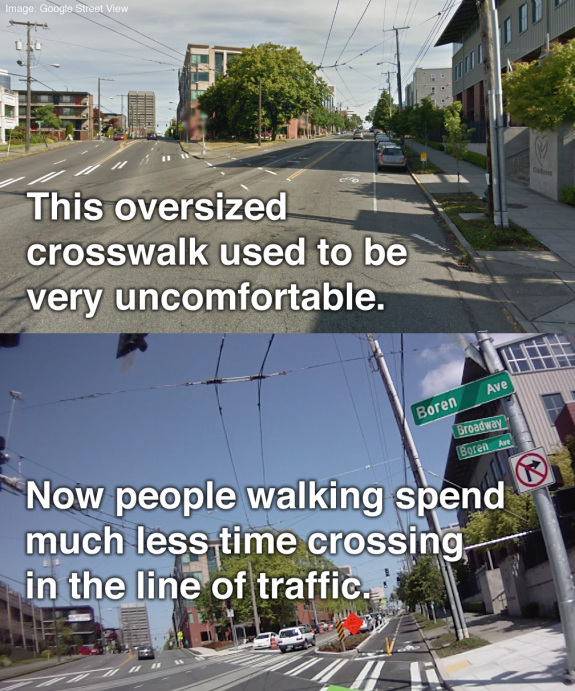
It’s been shown over and over that quality protected bike lanes improve safety for all road users. In fact, protected bike lanes are one of the most effective tools we have to improve safety and comfort for people on foot.
There are many reasons for this, but the Green Lane Project recently highlighted four of these reasons on their blog, and they used Seattle twice to illustrate their point:
- Protected bike lanes shorten crossing distances
- Protected bike lanes make it easier to know which direction cars are coming from
- Dedicated signal phases prevent turning conflicts with people walking
- Protected bike lanes reduce traffic weaving
To learn more about each point, check out the blog post.
As Seattle looks to make effective changes to its most dangerous streets, it’s important to realize that protected bike lanes are only partly a tool for helping people get around town on bikes. They are also a way to make a street safer for everyone. That why at times it may make sense for the city to install bike lanes on a street that is not listed on the Bike Master Plan. Like Rainier Avenue.
Below is a before/after from one Broadway intersection illustrating how the bikeway has dramatically improved comfort and safety for people on foot:









Comments
16 responses to “Green Lane Project: Here’s why protected bike lanes improve safety for people walking”
Just as Portland deliberately abandoned the ‘bike boulevard’ nomenclature (as a bike-only product failed to generate enough political support to be sustainable) and improvements for a more inclusive greenways vision, perhaps there is a similar message to be taken here.
Personally, I was surprisedly by how little the Broadway cycle track improved the perceived walking conditions for me, since it did little to consistently prevent cars from turning into me at high speeds when I have the right of way to cross.
I immediately noticed the improved comfort for pedestrians on the new 2nd Ave bike lanes. I haven’t traveled on Broadway enough to get a feel for it.
Broadway is still a mess for both the cycletrack and pedestrians, mostly due to the construction that is still going on for the Light Rail station and that the street car isn’t running yet.
I’ve parked a few times along the new Broadway bikeway. Motorists have to cross the bikeway mid-block 4 times, and it always feels like we’re jaywalking. This pedestrian doesn’t feel more comfortable.
In these situations, who’s got the right-of-way? Auto passengers walking to/from the public sidewalk, who have no other option, or the cyclists?
Really good question. I’d be interested an answer as well: are separated bike paths legally treated like a road, where pedestrians have to yield to vehicles when not at an intersection, or are they legally treated like sidewalks, where bicycles need to yield to pedestrians in all cases?
1) It’s always prohibited to run over a pedestrian. A vehicle (be it bike or car) is not permitted to run down pedestrians mid-block. True, the pedestrian isn’t supposed to cross mid-block, but that doesn’t mean you add on the additional wrong of thinking they’re fair game to run over if the pedestrian does enter mid-block.
2) The bike lanes are a special designation of roadway, like a bus only lane. If they were sidewalks then it would actually be fair game for dog walkers, scooters, electric wheelchairs, etc.
Yes. It really doesn’t matter what the law says, whoever is moving faster in a bigger vehicle has the responsibility not to hit others. This is a legal requirement but it’s also just the obviously right thing to do.
Technically, a person crossing a roadway at other than a crosswalk is required to yield, says the law: http://apps.leg.wa.gov/RCW/default.aspx?cite=46.61.240
But in practice, it’s best to make eye contact, slow down and be cautious. If they don’t see you, don’t plow ahead. Use common sense. Sometimes folks will wait, other times it makes sense to let people cross. The nice thing about biking is that you can actually speak or use body language to communicate with other road users.
What a reversal of the door-zone scenario! If the bike lane is on the other side, of course people involved in parking are required to yield to people biking in order to enter a parking space and before opening their doors. Driver compliance is pretty good but the consequences of driver non-compliance are dire for anyone on a bike that gets hit, who have limited control over the matter and limited ability to predict what any car within their field of vision will do. The responsibility and agency falls on one group but essentially all the risk is assumed by the other.
With the cycletrack the act of parking is easier for everyone involved. People that have just parked interact with people on bikes only on foot. The responsibility is shared, the risk is shared, and the agency is shared; this time the people emerging from parked cars are somewhat more vulnerable, instead of vastly less vulnerable. Surely sometimes people in either position will behave uncharitably. Under bike lanes man exploits man; under cycletracks man exploits man. But the change in consequences is almost certainly a positive change on balance, at least in an area where there’s both lots of biking and lots of parking turnover.
The Broadway cycletrack is signed by SDOT as an off-street “path,” not a part of the roadway.
That’s consistent with the State Supreme Court’s reasoning in Pudmaroff, which found that facilities maintained for bicycles but not motor vehicles did not fit the definition of a road.
Cycletracks aren’t actually defined anywhere in the Municipal Code or the RCW, but it appears likely the courts will find them to be sidepaths, not part of the road, consistent with SDOT’s designation and past precedent. (But I am not a lawyer, and don’t know of any incidents pending yet that will force a clarification of their status.)
Well, I guess the final answer is “we don’t know” when it comes to peds crossing protected bikeways. Both peds and bikes have to watch out and avoid each other, and after the first injury accident the courts will decide who had the right of way and who should’ve yielded.
Your Bicycle Club, its members and other bicyclists are paying for this – right – not with car tabs ; but with absolutely necessary bike licenses and tabs?
The confusion of these streets is remarkable – too much paint and too many lines.
When I was growing up here – we knew where to walk and drive.
If you find driving confusing you should perhaps consider another form of transportation that doesn’t involve endangering your fellow citizens due to your ineptitude.
Neat, I didn’t know Tom had his own Bicycle Club!
And yes, they’re paying for it through general fund taxes, like property taxes. For details, see
http://www.seattlemet.com/news-and-profiles/publicola/articles/we-all-pay-for-the-roads
Not happy that two heavily used northbound bus stops on Broadway across Seattle College were eliminated to accommodate this bike lane.
Otherwise I am glad that protected bike lines are happening.
Thanks for the shout, Tom! Tiny correction: that chart image is ours (or Google Sheets’, I suppose), based on data from NYCDOT.
Updated the caption. Thanks!